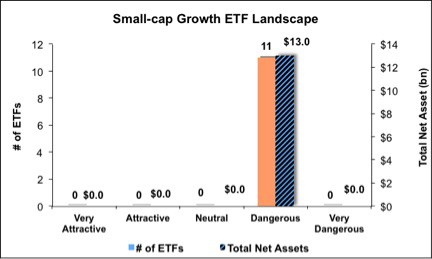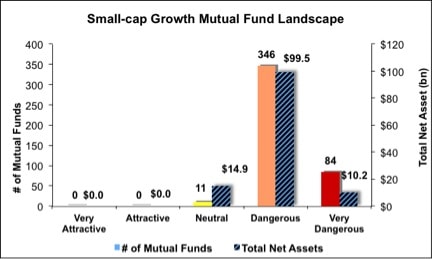The Small Cap Growth style ranks tenth out of the twelve fund styles as detailed in my Style Rankings for ETFs and Mutual Funds report. It gets my Dangerous rating, which is based on aggregation of ratings of 11 ETFs and 441 mutual funds in the Small Cap Growth style as of October 23, 2013. Prior reports on the best & worst ETFs and mutual funds in every sector and style are here.
Figure 1 ranks from best to worst the nine small-cap growth ETFs that meet our liquidity standards and Figure 2 shows the five best and worst-rated small-cap growth mutual funds. Not all Small Cap Growth style ETFs and mutual funds are created the same. The number of holdings varies widely (from 23 to 1709). This variation creates drastically different investment implications and, therefore, ratings. The best ETFs and mutual funds allocate more value to Attractive-or-better-rated stocks than the worst, which allocate too much value to Neutral-or-worse-rated stocks.
To identify the best and avoid the worst ETFs and mutual funds within the Small Cap Growth style, investors need a predictive rating based on (1) stocks ratings of the holdings and (2) the all-in expensesof each ETF and mutual fund. Investors need not rely on backward-looking ratings. My fund rating methodology is detailed here.
Investors should not buy any Small Cap Growth ETFs or mutual funds because none get an Attractive-or-better rating. If you must have exposure to this style, you should buy a basket of Attractive-or-better rated stocks and avoid paying undeserved fund fees. Active management has a long history of not paying off.Here’s the list of our top-rated stocks.
Get my ratings on all ETFs and mutual funds in this style by searching for Small Cap Growth on my freemutual fund and ETF screener.
Figure 1: ETFs with the Best & Worst Ratings – Top 4
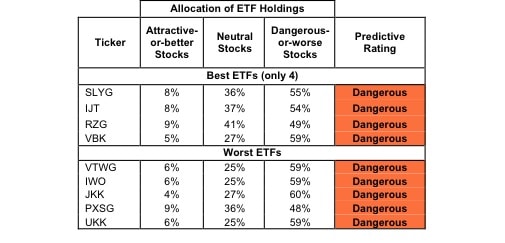 * Best ETFs exclude ETFs with TNAs less than $100 million for inadequate liquidity.
* Best ETFs exclude ETFs with TNAs less than $100 million for inadequate liquidity.
Sources: New Constructs, LLC and company filings
Vanguard S&P Small-Cap 600 Growth ETF (VIOG) and First Trust Small Cap Growth AlphaDEX Fund (FYC) are excluded from Figure 1 because their total net assets (TNA) are below $100 million and do not meet our liquidity minimums.
Figure 2: Mutual Funds with the Best & Worst Ratings – Top 5
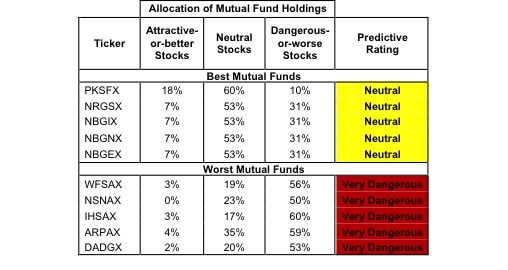 * Best mutual funds exclude funds with TNAs less than $100 million for inadequate liquidity.
* Best mutual funds exclude funds with TNAs less than $100 million for inadequate liquidity.
Sources: New Constructs, LLC and company filings
State Street SPDR SPDR S&P 600 Small Cap Growth ETF (SLYG) is my top-rated Small Cap Growth ETF and Virtus Equity Trust: Virtus Small-Cap Core Fund (PKSFX) is my top-rated Small Cap Growth mutual fund. SLYG earns my Dangerous rating and PKSFX earns my Neutral rating.
ProShares Ultra Russell2000 Growth (UKK) is my worst-rated Small Cap Growth ETF and Dunham Funds: Dunham Small Cap Growth Fund (DADGX) is my worst-rated Small Cap Growth mutual fund. UKK earns my Dangerous rating and DADGX earns my Very Dangerous rating.
Figure 3 shows that 181 out of the 1971 stocks (over 7% of the market value) in Small Cap Growth ETFs and mutual funds get an Attractive-or-better rating. However, zero out of 11 Small Cap Growth ETFs and zero out of 441 Small Cap Growth mutual funds get an Attractive-or-better rating.
The takeaways are: mutual fund managers allocate too much capital to low-quality stocks and Small Cap Growth ETFs hold poor quality stocks.
Figure 3: Small Cap Growth Style Landscape For ETFs, Mutual Funds & Stocks
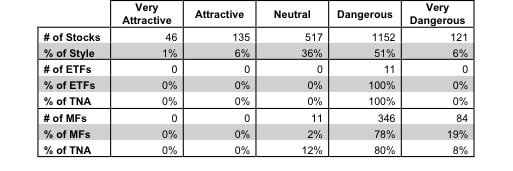 Sources: New Constructs, LLC and company filings
Sources: New Constructs, LLC and company filings
As detailed in “Low-Cost Funds Dupe Investors”, the fund industry offers many cheap funds but very few funds with high-quality stocks, or with what I call good portfolio management.
Investors need to tread carefully when considering Small Cap Growth ETFs and mutual funds, as 100% of Small Cap Growth ETFs and 88% of Small Cap Growth mutual funds earn a Dangerous-or-worse rating. No ETFs or mutual funds in the Small Cap Growth style allocate enough value to Attractive-or-better-rated stocks to earn an Attractive rating. Investors would be better off by focusing on individual stocks instead.
Questcor Pharmaceuticals, Inc. (QCOR) is one of my favorite stocks held by Small Cap Growth ETFs and mutual funds, earns my Very Attractive rating and a spot on October’s list of Most Attractive stocks. Questcor is a biopharmaceutical company that focuses on researching and producing treatments for autoimmune and inflammatory disorders. The company has grown after-tax profits (NOPAT) by 45% compounded annually over the last six years and has generated positive and growing economic earnings over the last four. The most impressive aspect of the company, however, is that Questcor has maintained a top-quintile return on invested capital (ROIC) since 2010.
This strong profit growth has not gone unnoticed as the price of QCOR has risen by 162% year-to-date. The stock currently trades at $68/share, which gives it a price-to-economic book value (PEBV) of 1.4. This valuation implies that the market expects Questcor’s profits to permanently increase by 40% over the remainder of its existence. Given the company’s recent 45% NOPAT growth rate over the past six years, these expectations seem too pessimistic. Strong growth and a modest valuation make QCOR an attractive choice for investors.
Lithia Motors, Inc. (LAD) is one of my least favorite stocks held by Small Cap Growth ETFs and mutual funds and earns my Dangerous rating. Lithia Motors has grown after-tax profits (NOPAT) by only 3% compounded annually over the last eight years. The company generated a return on invested capital (ROIC) of 6% in 2012, which puts it in the fourth-quintile of companies that I cover. Lithia Motors has also failed to generate any positive economic earnings in the past 15 years.
For a company with such a poor track record of growth, LAD is very expensive. To justify its current price of ~$69/share, the company would have to increase NOPAT by 19% compounded annually over the next 12 years. Having only grown NOPAT by 3% compounded annually over the last 8 years, these expectations seem too high. Poor growth and high expectations make LAD a risky investment.
Figures 4 and 5 show the rating landscape of all Small Cap Growth ETFs and mutual funds.
My Style Rankings for ETFs and Mutual Funds report ranks all styles and highlights those that offer the best investments.
Figure 4: Separating the Best ETFs From the Worst Funds
Sources: New Constructs, LLC and company filings
Figure 5: Separating the Best Mutual Funds From the Worst Funds
Sources: New Constructs, LLC and company filings
Review my full list of ratings and rankings along with reports on all 11 ETFs and 441 mutual funds in the Small Cap Growth style.
Jared Melnyk contributed to this report.
Disclosure: David Trainer is long QCOR. David Trainer and Jared Melnyk receive no compensation to write about any specific stock, sector, style or theme.


